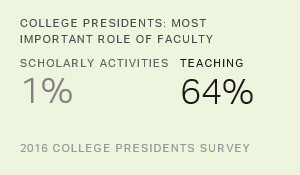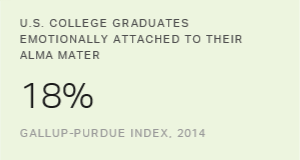America's higher education system faces numerous challenges, including soaring costs, public demands for greater accountability and growing skepticism of the value of a college degree. Findings from a recent offer insights into how higher education might right itself from arguably its most pressing challenge -- how to best engage and educate students for bright and meaningful futures. Namely, while higher education leaders express the values of teaching and student success, they are not creating campus cultures that prioritize these values.
When evaluating the importance of faculty members' roles, college presidents place "teaching" first -- 64% indicate teaching is their most important role, followed by "student success (i.e., degree completion)" and "advising students." A mere 1% of presidents say "scholarly activities, such as publishing and presenting research" is most important, and only 26% regard it within faculty's three most important responsibilities. In fact, research only beats "administrative and departmental duties" and "community service" in its importance of specific faculty duties.
| Most important | Second most | Third most | Net (all three) | ||||||||||||||||||||||||||||||||||||||||||||||||||||||||||||||||||||||||||||||||||||||||||||||||
|---|---|---|---|---|---|---|---|---|---|---|---|---|---|---|---|---|---|---|---|---|---|---|---|---|---|---|---|---|---|---|---|---|---|---|---|---|---|---|---|---|---|---|---|---|---|---|---|---|---|---|---|---|---|---|---|---|---|---|---|---|---|---|---|---|---|---|---|---|---|---|---|---|---|---|---|---|---|---|---|---|---|---|---|---|---|---|---|---|---|---|---|---|---|---|---|---|---|---|---|
| % | % | % | % | ||||||||||||||||||||||||||||||||||||||||||||||||||||||||||||||||||||||||||||||||||||||||||||||||
| Teaching | 64 | 21 | 8 | 93 | |||||||||||||||||||||||||||||||||||||||||||||||||||||||||||||||||||||||||||||||||||||||||||||||
| Student success (i.e., degree completion) | 24 | 34 | 18 | 76 | |||||||||||||||||||||||||||||||||||||||||||||||||||||||||||||||||||||||||||||||||||||||||||||||
| Advising students | 1 | 18 | 27 | 46 | |||||||||||||||||||||||||||||||||||||||||||||||||||||||||||||||||||||||||||||||||||||||||||||||
| Preparing students for employment | 7 | 14 | 20 | 41 | |||||||||||||||||||||||||||||||||||||||||||||||||||||||||||||||||||||||||||||||||||||||||||||||
| Scholarly activities, such as publishing and presenting research | 1 | 10 | 15 | 26 | |||||||||||||||||||||||||||||||||||||||||||||||||||||||||||||||||||||||||||||||||||||||||||||||
| Administrative and departmental duties | 0 | 1 | 7 | 8 | |||||||||||||||||||||||||||||||||||||||||||||||||||||||||||||||||||||||||||||||||||||||||||||||
| Community service | <1 | <1 | 3 | 4 | |||||||||||||||||||||||||||||||||||||||||||||||||||||||||||||||||||||||||||||||||||||||||||||||
| Other | 3 | 2 | 2 | 7 | |||||||||||||||||||||||||||||||||||||||||||||||||||||||||||||||||||||||||||||||||||||||||||||||
| Gallup | |||||||||||||||||||||||||||||||||||||||||||||||||||||||||||||||||||||||||||||||||||||||||||||||||||
It makes sense that college presidents view teaching as faculty's most important responsibility. Indeed, teaching lies at the heart of higher education's mission, offering students intellectual growth, an expanded skill set, and pathways to becoming engaged and informed professionals and citizens. But if presidents highly value teaching, why is the practice woefully underappreciated, underrecognized and undersupported in much of academe?
Hiring and tenure decisions at colleges and universities reveal a contradiction between the value that college presidents place on teaching and the actions they take to prioritize it. An increasing proportion of faculty appointments is devoted to part-time or non-tenure-track positions, with over 70% of all college instruction being offered by contingent faculty. Non-tenure-track positions are paid less and receive fewer -- if any -- benefits, typically compensated only for hours spent in the classroom. It's easy to imagine how this incites lower faculty engagement, higher turnover and declining instructional quality.
In contrast, tenure-track faculty are better compensated and more secure in their employment. Yet at many four-year institutions, they are assessed primarily on their research and publication output and not on their efforts or ability to engage students and further student growth. The recent advice dispensed by Stephen Walt in "" emphasizes the primacy of conducting "important research" in pursuit of tenure. Walt, professor of international relations at Harvard University, eschews quality teaching in pursuit of tenure, allowing that being a good teacher "never hurts" but is "its own reward." No need to prepare for lectures, hone one's curriculum or stay current on emerging pedagogy when these priorities suggest teaching is secondary. Academic advising and student mentorship likewise don't warrant mentions in Walt's lengthy guidance on securing tenure.
Sadly, the mantra of "publish or perish" for faculty has eclipsed the importance of engaging students in the acquisition of knowledge and opening their minds to disciplines and challenges that may possibly become their life's work and passion. While research appears central to acquiring tenure, engaging, educating and mentoring students is often relegated to poorly compensated and underappreciated non-tenure-track faculty or other professional staff.
Many scholars have accepted -- and even perpetuated -- the situation, but some within their ranks recognize that higher education has gone astray. In "," Jacques Berlinerblau laments this retreat from engaging and supporting students:
"No decision we ever made could have been more catastrophic than this one: Somewhere along the way, we spiritually and emotionally disengaged from teaching and mentoring students. While teaching undergraduates is, normally, a large part of a professor's job, success in our field is correlated with a professor's ability to avoid teaching undergraduates." [Emphasis in original]
The term "catastrophic" may seem dramatic to some, but Gallup's research supports Berlinerblau's assertion that the status quo undermines institutions' ability to deliver on their mission to set graduates on a course for engaged, meaningful and productive lives. The , an examination of the lifelong outcomes of U.S. college graduates, has identified that strongly link to workplace engagement and overall well-being after college. Three of these experiences reflect the importance of direct faculty-student engagement: having professors who demonstrated care and concern for students, having professors who made students excited about learning, and having mentors who encouraged students' goals and dreams. Another two highlight curricular priorities promoting deep and meaningful learning: having internships or jobs that reinforced classroom learning and working on projects that took a semester or more to complete. Both types of experiential learning demand faculty attention and support.
The following elevated odds reflect the experiences of a representative sample of U.S. college graduates who strongly agree with each statement:
| Support | ||||||||||||||||||||||||||||||||||||||||||||||||||||||||||||||||||||||||||||||||||||||||||||||||||||
|---|---|---|---|---|---|---|---|---|---|---|---|---|---|---|---|---|---|---|---|---|---|---|---|---|---|---|---|---|---|---|---|---|---|---|---|---|---|---|---|---|---|---|---|---|---|---|---|---|---|---|---|---|---|---|---|---|---|---|---|---|---|---|---|---|---|---|---|---|---|---|---|---|---|---|---|---|---|---|---|---|---|---|---|---|---|---|---|---|---|---|---|---|---|---|---|---|---|---|---|---|
| 1.4x higher if ... | My professors at (University Name) cared about me as a person. | |||||||||||||||||||||||||||||||||||||||||||||||||||||||||||||||||||||||||||||||||||||||||||||||||||
| 1.4x higher if ... | I had a mentor who encouraged me to pursue my goals and dreams. | |||||||||||||||||||||||||||||||||||||||||||||||||||||||||||||||||||||||||||||||||||||||||||||||||||
| 1.4x higher if ... | I had at least one professor at (University Name) who made me excited about learning. | |||||||||||||||||||||||||||||||||||||||||||||||||||||||||||||||||||||||||||||||||||||||||||||||||||
| 1.5x higher if ... | ALL THREE | |||||||||||||||||||||||||||||||||||||||||||||||||||||||||||||||||||||||||||||||||||||||||||||||||||
| Experiential Learning | ||||||||||||||||||||||||||||||||||||||||||||||||||||||||||||||||||||||||||||||||||||||||||||||||||||
| 1.3x higher if ... | I had an internship or job that allowed me to apply what I was learning in the classroom. | |||||||||||||||||||||||||||||||||||||||||||||||||||||||||||||||||||||||||||||||||||||||||||||||||||
| 1.2x higher if ... | I was extremely active in extracurricular activities and organizations while attending (University Name). | |||||||||||||||||||||||||||||||||||||||||||||||||||||||||||||||||||||||||||||||||||||||||||||||||||
| 1.2x higher if ... | I worked on a project that took a semester or more to complete. | |||||||||||||||||||||||||||||||||||||||||||||||||||||||||||||||||||||||||||||||||||||||||||||||||||
| 1.4x higher if ... | ALL THREE | |||||||||||||||||||||||||||||||||||||||||||||||||||||||||||||||||||||||||||||||||||||||||||||||||||
| GALLUP | ||||||||||||||||||||||||||||||||||||||||||||||||||||||||||||||||||||||||||||||||||||||||||||||||||||
| Support | ||||||||||||||||||||||||||||||||||||||||||||||||||||||||||||||||||||||||||||||||||||||||||||||||||||
|---|---|---|---|---|---|---|---|---|---|---|---|---|---|---|---|---|---|---|---|---|---|---|---|---|---|---|---|---|---|---|---|---|---|---|---|---|---|---|---|---|---|---|---|---|---|---|---|---|---|---|---|---|---|---|---|---|---|---|---|---|---|---|---|---|---|---|---|---|---|---|---|---|---|---|---|---|---|---|---|---|---|---|---|---|---|---|---|---|---|---|---|---|---|---|---|---|---|---|---|---|
| 1.7x higher if ... | My professors at (University Name) cared about me as a person. | |||||||||||||||||||||||||||||||||||||||||||||||||||||||||||||||||||||||||||||||||||||||||||||||||||
| 1.9x higher if ... | I had a mentor who encouraged me to pursue my goals and dreams. | |||||||||||||||||||||||||||||||||||||||||||||||||||||||||||||||||||||||||||||||||||||||||||||||||||
| 1.7x higher if ... | I had at least one professor at (University Name) who made me excited about learning. | |||||||||||||||||||||||||||||||||||||||||||||||||||||||||||||||||||||||||||||||||||||||||||||||||||
| 2.0x higher if ... | ALL THREE | |||||||||||||||||||||||||||||||||||||||||||||||||||||||||||||||||||||||||||||||||||||||||||||||||||
| Experiential Learning | ||||||||||||||||||||||||||||||||||||||||||||||||||||||||||||||||||||||||||||||||||||||||||||||||||||
| 1.8x higher if ... | I had an internship or job that allowed me to apply what I was learning in the classroom. | |||||||||||||||||||||||||||||||||||||||||||||||||||||||||||||||||||||||||||||||||||||||||||||||||||
| 1.6x higher if ... | I was extremely active in extracurricular activities and organizations while attending (University Name). | |||||||||||||||||||||||||||||||||||||||||||||||||||||||||||||||||||||||||||||||||||||||||||||||||||
| 1.7x higher if ... | I worked on a project that took a semester or more to complete. | |||||||||||||||||||||||||||||||||||||||||||||||||||||||||||||||||||||||||||||||||||||||||||||||||||
| 2.0x higher if ... | ALL THREE | |||||||||||||||||||||||||||||||||||||||||||||||||||||||||||||||||||||||||||||||||||||||||||||||||||
| GALLUP | ||||||||||||||||||||||||||||||||||||||||||||||||||||||||||||||||||||||||||||||||||||||||||||||||||||
These experiences are similarly aligned with graduates' strong agreement that their education was worth the cost -- an outcome leaders seemingly struggle to demonstrate. These experiences are also linked to graduates believing , graduates completing their degree in four years or less and .
These findings speak to the centrality of faculty engaging more deeply with students and the curricular experience. So why are universities not assessing, incentivizing, developing and rewarding faculty for teaching, and not recognizing the myriad opportunities for faculty to mentor and advise students throughout their undergraduate years?
The risk of maintaining our current priorities cannot be understated. Pressures against higher education show no signs of abatement. Where fault lines exist between faculty and staff, faculty and administrators, and tenured and non-tenure-track faculty, they may be traced in part to contradictions evidenced in what presidents say they value and how they reward and incentivize these groups. Given the downside, one might reasonably ask what higher education leaders have to lose.
Jeffrey M. Jones conducted analysis for this study.
Helen Stubbs is Senior Consultant for Gallup's Education Practice.


